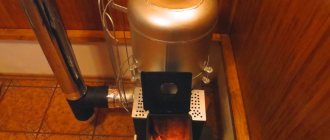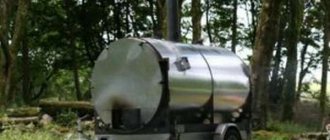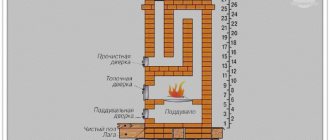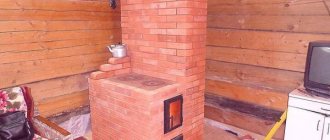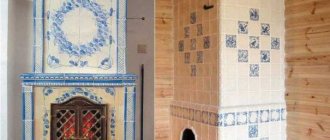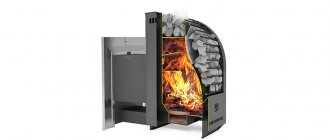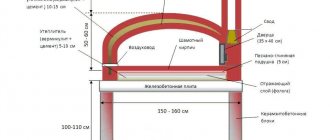What is the Bubafonya stove made of?
When making the stove, the craftsman used materials that he had in his workshop. The oven can be made on the basis of a simple metal barrel, or it can be a piece of pipe with thick walls, one end of which is welded, or it can be a container in the form of a cylinder. The main thing is that the bottom of the oven is well sealed, and the top is closed tightly with a lid. The internal part is equipped with a piston with a weight, a pipe and air dividers. The outlet pipe is welded to the top of the housing. The clamp and fiberglass are used to connect the pipe and pipeline. Fiberglass fabric will reduce heat loss.
To make the structure convenient to use, you need to weld metal handles onto the lid and outer wall.
Do-it-yourself Bubafonya stove
Main elements of the furnace:
- Fuel tank (fuel is directly loaded into it, and combustion occurs here);
- Heat removal pipeline (connected to the main pipeline of the heating system using a clamp and heat-insulating material);
- Pressure circle with weight and supply pipeline;
- flap;
- Oven cover.
This type of stove is easy to make; any owner can easily make it.
To make a Bubafonya stove at home, you will need the following materials:
- 2 steel pipes;
- barrel with a capacity of about 200 liters;
- channel;
During the manufacturing process you will need the following tools:
- Bulgarian;
- hacksaw for metal;
- hammer;
- welding machine.
Furnace assembly steps:
- The top of the barrel is carefully cut off.
- A hole for a pipe with a diameter of 10 cm is cut out in the center of the resulting circle.
- The pipe is welded to the resulting hole.
- 4 pieces of channel are welded crosswise to one side of the circle for weight and strength. This pressure circle is needed to press down the fuel and provide the combustion chamber with oxygen, thereby maintaining long-term combustion.
- At the bottom of the barrel you need to make doors for storing fuel - use a grinder to cut a rectangular hole. Thick metal curtains are welded to the resulting piece of metal.
- In a similar way, smaller doors are made a little lower, which are needed for removing ash.
- A chimney is necessary for any stove installed indoors, since through it combustion products will be discharged outside. The chimney also creates the necessary draft.
To ensure proper functioning of the structure, it is necessary to prepare two sections of pipe, the diameter of which is 200-250 mm.
The first of them is made about 400 mm long, inserted horizontally into the upper part of the body, and then welded. The second section is the main chimney, connected to the previous one at an angle of 90 degrees.
- A reflector is usually installed near the stove. Firstly, it will protect the room from fire, since the stove gets very hot. Secondly, it helps heat spread better and more evenly in the room. To make the reflector, heat-resistant materials must be used.
- The bubafonya stove should be installed on a foundation. During operation, its lower part becomes quite hot. Therefore, you will definitely need a foundation. This will protect the room from fire. The foundation should be laid thoroughly and fire-resistant bricks should be used for laying.
- Make a hole in the ground with dimensions of 100x100 cm and a depth of 20 cm.
- Fill in crushed stone or broken unnecessary bricks. Spray with liquid solution and let dry.
- Once dry, lay out two rows of fire bricks.
- When laying, use a building level and maintain parallelism to the created plane.
Making a furnace from a cylinder, pipe or sheet steel
You can also make the stove itself from an empty gas cylinder, a wide pipe or a piece of sheet steel.
In the first option, as in a barrel, the upper part is simply cut off, which is then used as a pressure circle.
In the second, two circles are cut out of a sheet of steel, the same diameter as the pipe.
Then one of them is welded to the pipe as a bottom, and a lid is made from the second to press the fuel.
In the third, a cylinder is rolled from a wide sheet of steel and the seam is welded. Then, as in the second method, two circles are cut out - the bottom and the lid.
The easiest option for creating a stove at home is to use thick-walled pipes, barrels or an industrial gas cylinder.
But here it is important to understand that in the combustion zone there will be very high temperatures, which will require a workpiece wall thickness of at least 4-5 mm. It is also important to be able to work with a grinder and a welding machine, since you will have to cook a lot.
When selecting material for the firebox body, it is also important to choose the correct diameter of the workpiece. The optimal option is in the range from 300 to 800 mm.
It should be remembered that the height of the body must be strictly proportional to the diameter in a ratio from 3:1 to 5:1.
Based on the conditions in which the stove will be used, it will not be difficult for you to choose the most optimal diameter for yourself.
For example, a product made from a gas cylinder will quite successfully heat a workshop or garage. And if you adapt a water circuit to it, you can handle the heating of a small house.
The next thing we need is a sheet of metal for the load and a piece of pipe for the air duct. A pipe is needed with a diameter of approximately half the cross-section of the chimney, which is calculated according to a certain formula, and for the option with a gas cylinder it should be at least 110 mm, and the optimal option is 150 (prepare the required amount of such pipe for its installation).
Thus, our air duct should have an internal diameter of 60 to 80 mm. The length of the pipe section for the air duct must be 300 mm greater than the height of the top point of the cylinder.
With metal for pressing, everything is simple: a sheet 2.5 mm thick is enough, and we will weigh it down with four pieces of channel, angle, or the same sheet metal.
If you have prepared all this, you can begin building this heating device.
If some non-standard container is used to make a stove, and the drawing found is designed for a gas cylinder or a 200 liter barrel, then it is better to calculate at least the basic parameters so that the stove works with maximum efficiency.
These include:
- Stove dimensions.
The optimal container diameter is 30-80 cm. The ratio of its diameter to height is in the range from 1:3 to 1:5. If this proportion is violated to a lesser extent, air will not flow into the combustion zone, but will simply go out into the chimney.
If the indicator is too high, combustion will be observed in the center of the bookmark and absent near the walls. As a result, the pressure circle will jam due to its subsidence, and combustion will no longer be maintained.
- Cylinder wall thickness.
This parameter has a particularly large weight when installing a water circuit. The minimum value should not be allowed to be less than 4 mm.
If the stove is used only to heat one room such as a garage, basement or greenhouse, then it is permissible to use a container with walls of a smaller thickness (from 2.5 mm), but a loss of power is inevitable.
- Piston dimensions.
Not only the diameter of the pancake is important, but also the thickness of the metal. The optimal gap between it and the walls is 5% of the diameter. The thickness of a circle and its diameter are inversely proportional.
If this knot is heavy, it will sag and extinguish the fire, and if it is too light, it will not provide sufficient pressure.
- The cross-sectional area of the chimney outlet pipe.
It is determined by multiplying the energy output of the furnace in kW/h. by a factor of 1.75. In turn, the energy output value is obtained by multiplying the mass of the load by the specific heat output of the fuel used. If the volume of the working part of the furnace is known, then it is multiplied by the specific gravity and the mass of the filling is obtained.
- Parameters of the rod for air intake.
Its diameter is taken to be within 0.5-0.55 of the cross-sectional area of the outlet pipe.
Making a long-burning bubafonya stove with your own hands is not the most difficult task. But when manufacturing the structure, it is necessary to remember safety measures during subsequent operation of the device.
For example, the connection between the lid and the boiler body. This should be a tight joint without the slightest gap so that combustion products do not penetrate into the room. Here you can add a joint between the lid and the pipe to supply oxygen to the combustion zone.
It seems to have a simple design and simple materials, but everything must be carried out at a high quality level.
And if you do not have very good skills in working with a welding machine, then you should not start building this furnace. The quality will be low and safety requirements will not be met.
Pros and cons of the Bubafonya stove
Positive sides
The structure can be assembled very quickly and easily; its dimensions are quite compact. You can assemble it yourself, without the help of others. The stove and fuel for it are very affordable in price. Burning in a furnace is very long and does not require additional fuel, and you can regulate the fuel consumption itself and set the combustion intensity. The stove operates autonomously, without the use of electricity. Another plus is that the stove can be used for quite a long time without breakdowns, its design is subject to modernization, and if desired, it can be connected to a water heating system. The oven is easy to use; just clean the pipes from condensation with a brush.
Weak sides
Along with its positive aspects, the design also has its disadvantages. Condensation forms in the stove pipes, which needs to be cleaned; the pipes may freeze. To prevent the fuel tank from becoming unusable, you need to promptly remove ash and ash, which over time can form a dense mass with a solid base. When using the stove, you need to install a blower fan, which will disperse the gases that may be released during reverse combustion. After use, the oven cools down very quickly.
How does the stove work
Combustion principle from top to bottom. The fuel in the stove flares up from the air draft created by the pipe on the top cover. While the fuel is burning, the lid with the weight moves down, and the hot flow rises up and enters the pipe, which discharges the hot air into the pipeline. The intensity of the draft can be adjusted by adjusting the size of the gap using a damper that closes the pipe. With an increase in air draft, fuel combustion will also increase, but the combustion will not last long. You can use the gap to reduce combustion, then without additional fuel the stove will work for a very long time, from 6 to 16 hours.
Design and principle of operation
The Bubafonya stove received its original name after its designer, craftsman Afanasy Bubyakin. He took the Stropuva pyrolysis boiler produced in Lithuania as the basis for his design. The master simplified the design of the stove, so every craftsman can make it himself. A homemade pyrolysis furnace quickly gained popularity due to its high efficiency combined with ease of manufacture.
Before describing the design of the furnace in detail, it is worth considering the principle of its operation. Fuel in Bubafon burns according to the principle of a candle - from top to bottom. In fact, the firewood does not burn, but gradually smolders, releasing pyrolysis gas. A piston in the shape of a steel circle with ribs and a pipe in the middle is responsible for air distribution.
This part divides the cylindrical furnace body into two chambers:
lower - burning wood;- the upper one is the gas combustion chamber.
The base of the stove resembles a familiar potbelly stove, the efficiency of which is only 50 - 60%. When fuel burns in any wood-burning stove, gases are formed that dissolve uselessly in the air.
In pyrolysis boilers, this energy is used to heat the room. Efficiency rises to 80%. Bubafonya also works on the principle of a pyrolysis boiler.
This is ensured by its design:
- The base is a metal tank in the shape of a cylinder. At the bottom there is a grate and an inlet for air access.
- To protect against fire and prevent it from moving through the container, a protective screen is provided. To regulate the temperature, a damper is used to stop the air supply and combustion.
- An important design detail is the suppressor. This is a metal circle with welded ribs. They are needed to create an air gap, which will increase the smoldering time of the fuel.
- In the center of the suppressor there is a pipe for removing combustion products. A valve is mounted at its end, which allows you to regulate the volume of oxygen supplied inside the combustion chamber or completely shut it off when you need to stop operating the furnace.
- The furnace firebox is equipped with a lid with holes. This is an element of the gas combustion chamber. They pass through the gap between the housing walls and the piston disc. Complete removal of combustion products is carried out by a chimney connected to the upper part.
Correct use of the oven
The bottom of the fuel tank is loaded with small-sized firewood, which is laid out with paper and wood chips, and a fire is started in the stove using a match. After the piston with a load is installed in the tank and the lid is closed, now you need to set the required gap size at the valve and pipe, thereby establishing the desired degree of draft.
Remember to be safe and do not place anything that burns easily near the stove - furniture, fabric, paper, etc. Use protective gloves when loading fuel. Use flammable liquids, acetone, kerosene, and gasoline with great care when lighting.
DO NOT forget that if you use such liquids, first add it to the firewood, which is then placed in the oven, while making sure that your clothes and mittens do not accidentally catch fire. If the oven is used for cooking, then all actions can be performed only after the oven has completely warmed up, that is, after 15 minutes. The parts of a heated oven are very hot, so use gloves. If you block the supply of oxygen by closing the valve on the pipe, the combustion process will stop.
If you need to extinguish the stove very quickly, then use special fire suppressants. Do not use the stove to burn household waste and plastics, as they release harmful gases and clog the pipes with a layer of soot. Firewood for ignition must be dry, without resin deposits, which leads to the formation of condensation and soot. Firewood should be small and fit well into the fuel tank. Under no circumstances should you try to varnish or enamel parts that will then become hot. At high temperatures, the paint is highly flammable and produces toxic fumes. Use only paints that are resistant to high temperatures. Make sure that the structure is installed on a heat-resistant material.
How to improve the Bubafonya stove
The stove will protect any room from freezing in cold weather. The stove can also be combined with a water heating system. To do this, a so-called water “jacket” is built around the stove, and heating pipes are connected to it. Now the principle of operation of the furnace will be as follows: the heat of the furnace will heat the water that circulates through the pipes. The water “jacket” is made from two pieces of metal that need to be bent into a ring and welded. The result is a metal casing with a wall thickness of 2 mm. The furnace boiler is installed in this casing, the pipes through which water and air will flow are connected, and a suitable cover is selected. That's it, the finished heating structure is ready for use. To prevent heat loss, coat the walls of the heating tank with clay and lay brickwork.
“Bubafonya” is a long-burning heating device that directly heats the air in rooms for various purposes, running on wood fuel. Despite its small size, the stove has high heat output without additional loading of firewood. Such a stove can be made by almost any craftsman who has the necessary materials and a welding machine at hand.
Using simple materials, you can get a reliable source of heat, which is appreciated by many users. The stove is designed for economical use of fuel, which makes its use economically attractive. Today there are many heating devices, but the Bubafonya stove firmly holds its leading position among them, thanks to its simplicity and efficiency. Moreover, assembling such a stove according to the drawings will not be difficult and will not take a long time.
Bubafonya stove with water jacket
The design described above is used for air heating, but this is not all the possibilities of the design. In addition to air heating, it is possible to make a Bubafonya stove with a water circuit, which is also used on more advanced designs. This will significantly increase the heating capabilities of the stove.
To make a water jacket (25-30 mm thick), you will need another barrel of a larger diameter (or a square body) in which the coolant will be heated. If there is already a heating system in the room, then the stove is connected to it and the circulation pump moves the coolant from the water jacket into the heating circuit.
In the upper part there is a supply outlet, in the lower part there is a return.


